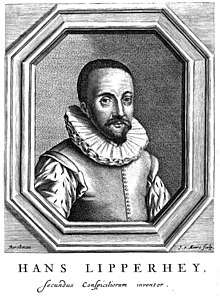Hans Lippershey
| Hans Lippershey | |
|---|---|
 | |
| Born |
1570 Wesel, Duchy of Cleves, Germany |
| Died |
September 1619 (aged 48–49) Middelburg, Netherlands |
| Nationality | German, Dutch |
| Occupation | spectacle-maker |
| Known for | Inventor of the telescope (earliest known patent application) |
Hans Lippershey (1570 – buried 29 September 1619), also known as Johann Lippershey or Lipperhey, was a German-Dutch spectacle-maker. He is commonly associated with the invention of the telescope, because he was the first one who tried to obtain a patent for it.[1] It is, however, unclear if he was the first one to build a telescope.
Biography
Lippershey was born in Wesel, now in western Germany, in 1570. He settled in Middelburg, the capital of the province of Zeeland, now in the Netherlands, in 1594, married the same year and became a citizen of Zeeland in 1602. During that time he became a master lens grinder and spectacle maker and established a shop. He remained in Middelburg until his death, in September 1619.
Invention of the telescope
Hans Lippershey is known for the earliest written record of a refracting telescope, a patent he filed in 1608.[2][3] His work with optical devices grew out of his work as a spectacle maker,[4] an industry that had started in Venice and Florence in the thirteenth century,[5] and later expanded to the Netherlands and Germany.[6]
Lippershey applied to the States General of the Netherlands on 2 October 1608 for a patent for his instrument "for seeing things far away as if they were nearby",[7] a few weeks before another Dutch instrument-maker's patent, that of Jacob Metius. Lippershey failed to receive a patent since the same claim for invention had also been made by other spectacle-makers[8][9] but he was handsomely rewarded by the Dutch government for copies of his design.
Lippershey's application for a patent was mentioned at the end of a diplomatic report on an embassy to Holland from the Kingdom of Siam sent by the Siamese king Ekathotsarot: Ambassades du Roy de Siam envoyé à l'Excellence du Prince Maurice, arrivé à La Haye le 10 Septemb. 1608 (Embassy of the King of Siam sent to his Excellency Prince Maurice, arrived at The Hague on 10 September 1608). This report was issued in October 1608 and distributed across Europe, leading to experiments by other scientists, such as the Italian Paolo Sarpi, who received the report in November, the Englishman Thomas Harriot, who was using a six-powered telescope by the summer of 1609, and Galileo Galilei, who improved the device.[10]
There are many stories as to how Lippershey came by his invention. One version has Lippershey observing two children playing with lenses in his shop and commenting how they could make a far away weather-vane seem closer when looking at it through two lenses. Other stories have Lippershey's apprentice coming up with the idea or have Lippershey copying someone else's discovery.[11] Lippershey's original instrument consisted of either two convex lenses with an inverted image or a convex objective and a concave eyepiece lens so it would have an upright image.[12] This "Dutch perspective glass" (the name "telescope" would not be coined until three years later by Giovanni Demisiani) had a three-times (or 3X) magnification.
The lunar crater Lippershey, the minor planet 31338 Lipperhey, and the exoplanet Lipperhey (55 Cancri d) are named after him.
Pronunciation
English speakers tend to interpret the letters 'sh' in the name as representing a single phoneme, the sibilant [ʃ, resulting in a pronunciation like /ˈlɪpərˌʃeɪ/. Both in German and in Dutch, however, the letters 's' and 'h' belong to different syllables and are pronounced separately. The German pronunciation is [ˈlɪpɐsˌhaɪ], whereas the Dutch pronunciation is closer to [ˈlɪpərsˌɦɛi].
Notes
- ↑ The History of the Telescope, by Henry C. King, page 30
- ↑ The History of the Telescope By Henry C. King, page 30
- ↑ Light Years: An Exploration of Mankind's Enduring Fascination with Light By Brian Clegg
- ↑ Fred Watson, Stargazer (page 55)
- ↑ galileo.rice.edu The Galileo Project > Science > The Telescope by Al Van Helden
- ↑ The History of the Telescope By Henry C. King, page 27, "(spectacles) invention, an important step in the history of the telescope"
- ↑ Osservatorio Astronomico di Bologna - TELESCOPES
- ↑ Osservatorio Astronomico di Bologna - TELESCOPES "The request however was turned down, also because other spectacle-makers had made similar claims at the same time."
- ↑ "The Hague discussed the patent applications first of Hans Lipperhey of Middelburg, and then of Jacob Metius of Alkmaar... another citizen of Middelburg, Zacharias Janssen had a telescope at about the same time but was at the Frankfurt Fair where he tried to sell it" galileo.rice.edu The Galileo Project > Science > The Telescope by Al Van Helden
- ↑ Van Helden (1977, p.40; 1985, p.65), Drake (1978, p.138)
- ↑ A people's history of science: miners, midwives, and "low mechanicks" By Clifford D. Conner
- ↑ A people's history of science: miners, midwives, and "low mechanicks" By Clifford D. Conner
References
- Drake, Stillman (1978). Galileo At Work. Mineola, NY: Dover. ISBN 0-486-49542-6.
- Van Helden, Albert (1977). The Invention of the Telescope. Philadelphia, PA: The American Philosophical Society. ISBN 0-87169-674-6.
- Van Helden, Albert (1985). Measuring the Universe. Chicago, IL: The University of Chicago Press. ISBN 0-226-84881-7.
External links
| Wikimedia Commons has media related to Hans Lippershey. |